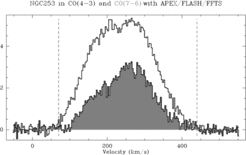Observations
Observations at higher frequencies, especially when operating at THz frequencies, require that spectrometers provide a larger bandwidth to allow for a complete coverage of the full line width of the observed object in one exposure. In Fig. 1 we show the spectra of the warm carbon monoxide towards the starburst nucleus of the galaxy NGC 253 as observed with APEX. Clearly, with an actual line width of more then 300 km/s, a spectrometer bandwidth of only 1 GHz is insufficient to study the emission of CO(7–6) at 806 GHz. However, by combining two 1 GHz wide spectrometers, offset in their IF center frequencies, it was possible to observe the complete emission in one integration, thus avoiding problems of cross-calibration, pointing errors, and platforming effects of otherwise sequential observations. On the other hand, to have a backend for spectral line surveys or narrow line sources, a high spectral resolution is required. The large number of spectral channels achievable with FFT spectrometers eliminates the disadvantage and complexity of having to reduce the bandwidth to get higher spectral resolution, which is commonly needed in autocorrelator systems, therefore making it better suited for combined broad band and high resolution observations.

The scientific results obtained during the first year of APEX operation as well as during telescope commissioning are presented in the A&A Vol. 454 No. 2 (August I 2006).
